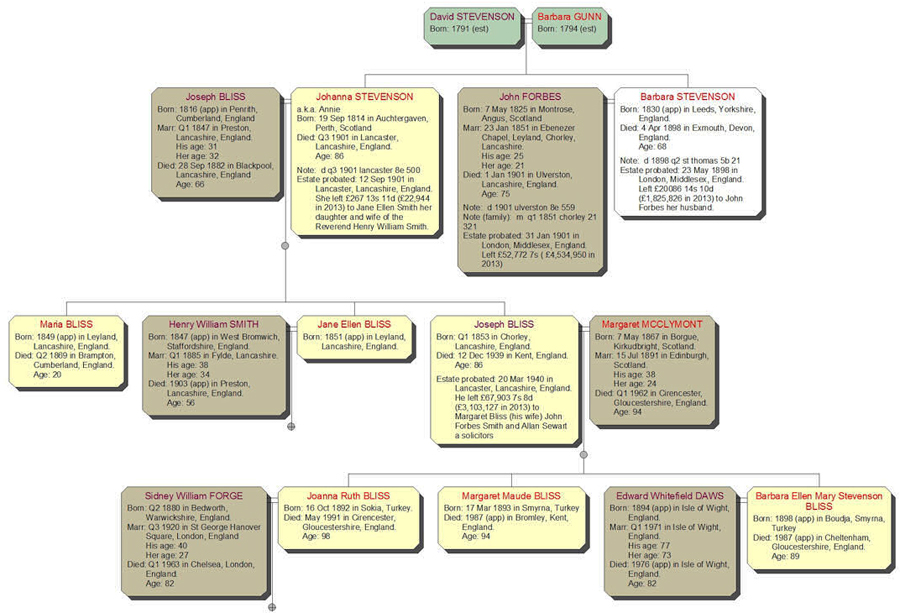
MacAndrews and Forbes and the Forbes Family - Wallis Kidd, 2016
Introduction
MacAndrews and Forbes was, and still is, a licorice (American liquorice) manufacturing and exporting company originally based in Smyrna, Asia Minor, and now a holding company, and part of a large multinational owned by millionaire Ronald Perelman in the USA. In this article I shall only deal with the early days of the company between about 1850 and 1950 which was essentially run by the Forbes family.
The Company Origins
The Companies origins start with one Robert McAndrew FRS 1802-1873, a noted scientist and collector of shells and owner of the MacAndrews Shipping Company in London and Liverpool who in 1850, always on the lookout for profitable produce to ship, and who was probably already shipping cotton and fruits from Smyrna into Europe, heard about licorice root being grown near Smyrna in Asia Minor and so decided to send one of his sons, 18 year old William Edward McAndrew 1803-1905, known as Edward, and his 21 year old Scottish friend William Forbes 1829-1917, from Montrose in Scotland to investigate. The two boys arrived at Smyrna in 1850 and travelled to the Meander valley to research the possibilities of exporting the root, in the footsteps of one Augustus Clarke, who was already at a basic factory at Cutzarli present day Koçarlı and who had previously, probably been sent on earlier exploratory trip by McAndrew. However it would seem that Sokia or Sochia now Söke just across the valley, presented a much better proposıtıon for a factory to process the root and then transport the paste by camel to Scala Nuova, now Kuşadası, where it could be shipped as necessary to the UK, Spain and America, although later America would only accept the unprocessed root for their own factory built in Newark in 1872.
And so the company was set-up; a factory was built at Söke, together with the necessary residence there for numerous western managers and their families and all initially financed by Robert McAndrew and the MacAndrews Shipping Company, in return for 50% of any profits. It would appear that until 1881 when the Aydin Railway was opened, the distance up the valley for new factories to be built, was limited by the cost of local camel transport to Scala Nuova but once the railway was in operation then cheap shipping to Smyrna was possible. Although there was already an office in the Sparteles Buildings in Smyrna comprising of only 2 rooms and run by General Manager William Henry Cadoux 1840-1899, the head office was still at Sokia until 1893.
Edward McAndrew finally returned to London in about 1857 to help his father in the family shipping business leaving the company in the Ottoman Empire in the capable hands of his friend William Forbes [a travel pass issued to him in 1861] and his 2 elder brothers, Andrew 1818-1868 and John 1825-1901. William briefly returned to the UK in 1864 to marry his sweetheart and Edwards younger sister, Eliza Ann McAndrew and on returning to Smyrna, William is joined by his two younger brothers David 1835-1918 and George 1838-1884.
Andrew the eldest brother and unmarried, tires of the company and leaves in 1864 to go back home to Scotland. He briefly meets and marries a young girl, one Magdelene Willocks, nearly 30 years his junior, who immediately gets pregnant and who delivers a son, David on 3rd October 1868. However unfortunately father Andrew, has already left his young wife in Perth, never to see his son, for he’s living in his mother’s old family home in Montrose about 100km away, deeply disturbed and sadly eight days later on 11th October 1868 his housekeeper, whilst delivering breakfast, finds him dead where he’s hung himself from a window. Nothing is known of David’s early life but I suspect he’s in contact with his Uncles in Turkey and even later as a young child may have lived with his Uncle George in Nazilli as he is mistakenly thought to be his son.
William, at the office in Smyrna retires in 1869, for control of the company passes to John whose been based at the head office in Söke but then moves to Smyrna where General Manager W H Cadoux has been running the office since 1863. John and his wife Barbara Stevenson never have any children of their own but probably look after younger brother George’s daughter Mary Isabella Barbara 1879-1963 and son George James John 1881-1899 as they are remembered by some in the “Levantines Recollections”. John’s younger brother David never marries and after running the factory at Nazilli goes to the US in 1869 and brother George takes over the plant. George being the youngest marries late in 1879 to one Eliza Brown in Liverpool, England and although the children visit the Levant it would appear that wife Eliza never did preferring to live in West Kirby, Lancashire, England. Later another factory is acquired in Aydin obviously in anticipation of the somewhat delayed railway, and so John builds himself his second house there, his first being in Nazilli.
The company at this point seems to be prospering, from R.S. Harrisons “History of MacAndrews and Forbes” he states that in 1880 profits were around £50,000 or around £4 million in today’s money! And during this period the company and its product becomes well established. The opening of the Aydin railway in 1881 enables a large reduction in transport costs and opening of more factories further afield, indeed the product becomes so profitable more agricultural sources are sort around the world, probably the one market making the difference was the addition of some extract in the manufacture of cigarettes in the US a process banned in the UK and the explosion of the confectionery industry in the late 19th century.
The American connection as stated previously, started with David Forbes together with one of Robert McAndrew’s nephews, James Child McAndrew 1827–1903 and the son or Robert’s eldest brother William Peter McAndrew 1790–1871. They were both accompanied by another Scotsman from Edinburgh, one Alexander Geddes 1839 –1904 at Newark, New Jersey, in the USA, and ultimately MacAndrews and Forbes would prevail in this American market and worldwide.
Glycyrrhiza Glabra
Glycyrrhiza glabra or liquorice plant, is a member of the pea and bean family, its scientific name is taken from the Greek for sweet root (glykys, meaning sweet, and rhiza, meaning root). It is cultivated for its rhizomes (underground stems) that contain the compound glycyrrhizin, which is 50 times sweeter than sugar. After cycles of about 3-4 years the root is dug up and shipped to local or remote plants for processing. For example the factory at Söke boiled the root over and over again till a thick black resin like paste was recovered and then poured into wooden boxes lined with paper and left to harden. The resultant 120 – 130 Kilogram block was a convenient size for transportation by camel, train and ship. There were various grades depending on use and customer, for example “VB – most expensive” and “VG – cheapest”. Later the blocks were reduced in size at some customers request, However as already mentioned the US insisted on processing their own root and in 1880 they were importing around 6000 tons a year. As most liquorice is used as a flavouring agent for tobacco, for example, M&F Worldwide reported in 2011 that approximately 63% of its liquorice product sales are to the worldwide tobacco industry for use as tobacco flavour enhancing and moistening agents in the manufacture of American blend cigarettes, moist snuff, chewing tobacco, and pipe tobacco. American blend cigarettes made up a larger portion of worldwide tobacco consumption in earlier years, and the percentage of liquorice products used by the tobacco industry was higher in the past. M&F sold approximately 73% of its liquorice products to the tobacco industry in 2005. And in 1975 that it was believed that well over 90% of the total production of liquorice extract and its derivatives found its way into tobacco products.
It’s also well-known as a medicinal plant, and is used in the production of cough mixtures and throat lozenges, as well as an ingredient to mask the unpleasant taste of some medicines. Glycyrrhiza glabra has been used to treat sore throats, mouth ulcers, stomach ulcers, inflammatory stomach conditions and indigestion. It is also used to combat food poisoning in modern Chinese herbalism. Liquorice rhizomes can be chewed or made into tea, which with other anti-spasmodic herbs is often taken for menstrual cramps. Liquorice is also used as filler in capsules and added to medicines as a sweetener to mask the unpleasant taste of other ingredients.
The Expansion of the Company
At the end of the 19th Century only one Forbes brother is left in the Levant, John, together with John’s nephew Joseph Bliss 1853 – 1939. Joseph’s mother was Johanna Stevenson and Barbara’s, John’s wife’s eldest sister). Joseph joined the company at Söke in about 1880, and later married one Margaret McClymont 1867-1962 in 1891 a teacher whom he met in Smyrna. The rest of the brothers you will remember, Andrew having died in 1868, William retired, David in the US and George prematurely dying at Nazilli in 1884 aged 46, however Andrew’s son another David now a young man and well-schooled in the art of the business is about to come on the scene.
The turn of the century sees many changes, not the least to MacAndrews and Forbes, William Cadoux, the General Manager in Smyrna, retires through ill health in 1883 after 20 years in Smyrna with the company takes his large family back to London and briefly sets up his own import business using his contacts gained in the Ottoman Empire. He’s succeeded by his eldest son Herbert William Cadoux 1871 – 1906, however Herbert is then persuaded to join one Thomas Sievwright Catto 1879–1959 in his import business, trading as T S Catto and sole London agents for MacAndrews and Forbes, later they join forces in 1904 with the M&F company after it has finally separated from its ‘50% of profits’ contract with Robert McAndrew. Herbert joins young David Forbes out in Smyrna as Assistant General Manager in 1904, a great linguist and traveller, and whom it would seem was destined for great things with the company, however he sadly he dies of a heart aneurysm whilst visiting one of the factories at Elizavetpol in Georgia the following year.
Herbert Cadoux’s Obituary
In 1906 the London office separates from the US and becomes MacAndrews and Forbes Ltd but still funded by the US and so still intimately linked. In 1910 TS Catto travels to the US to run the American connection and is elected Vice President before later resigning and travelling to Calcutta after the war in 1919, and then returning to the UK in 1928. After many senior company positions but not with MacAndrews and Forbes he was elected as the Governor of the Bank of England and a Baronetcy in 1946.
There are many people and places associated with MacAndrews and Forbes and the list would be inexhaustible to include everyone but local offices were opened in Aleppo, Baghdad, South Russia and Georgia, an office adjacent to Araxes River in Iran, Kurdamir in Azerbaijan, Alexandretta, Gastouni in Greece, Campagna in Italy, Coria del Rio in Spain and even China for a time until 1923 when that office was closed. Some other managerial names in no particular order were, W S Pearce, S Gordon, Boyd, S Joly, G Rendell, S Goram, D Lorimer, J A Lorimer, H S Beard, T G Joyce, J Evans, J Henley, J Orchardson, W B Lewis, C B Williamson, A Pengelley, F W Parry, R S Harrison, R G W Smith, T Struthers, A E C Bird, R Montgomery, J Hanson, T Fulton, Andrew Urquhart, Ben Hodder, Bernard Campling. There were many more, however I’d just like to talk about the last three names for a minute as they have quite a story behind them.
Andrew Urquhart
Andrew Urquhart was a local manager at the plant near Aydin in the Meander Valley around 1874 when he and his wife Beryl had a son John Leslie Urquhart. Later Andrew Urquhart briefly left the Company to start his own concern in Oudjari in the Caucasus, the Orient Trading Company which Herbert Cadoux, a later Assistant General Manager to David Forbes, also had links with before subsequently being absorbed once again by M&F in Smyrna.
Leslie as he was known, grew up to be quite an entrepreneur, and was known as the Russian and Australian Mining Tsar worth many millions of dollars, and a very good résumé of his life can be found here:
Ben Hodder 1892-1949
Ben Hodder on the left of the picture was a manager from Lincolnshire in England, with MacAndrews and Forbes in Söke in 1919 and from many of the photographs he would appear to be one of the main men in the company as well as a reservist Lieutenant in the Royal Navy and Captain of a Torpedo Boat of the Turkish coast after the Greek invasion of Anatolia in 1919 culminating in the expulsion of the Greek Army in 1922. In the Meander Valley many battles were fought by the local Zeybeks headed by Yörük Ali in support of the Turkish Army against the Greeks. Sadly there were many massacres of men, women and children on both sides in the backward and forward movements around Aydın. Lieutenant Hodder was in the thick of it and allegedly trying to keep the peace and negotiate between all parties, however it is to be assumed that he upset Yörük Ali so badly by appearing to side with the Greeks that after 1922, one hundred and fifty MacAndrews and Forbes employees were expelled by the Turkish government, although most were allowed back later, Ben Hodder was particularly picked out as “Personna Non-Grata”. Yörük Ali is alleged to have said “I should have killed Ben Hodder when I had the chance!” - Hodder’s official report July 1919.
Bernard Campling 1889-1950
Bernard Campling was a chemist with MacAndrews and Forbes at Söke and then later the plant manager. From a letter purchased from the internet written by Bernard Campling to Mr Ben Hodder on the 4th July 1919 from the managers house at Sochia, it reads, “Dear Mr Hodder, I was pleased to hear that you are still alive and well”, I guess he’s already involved by this time in skirmishes around Aydın? He continues, “Everything is quiet here. Owing to the communications having been broken, we have run out of tea and we shall be much obliged to you if you will kindly allow us to borrow enough to keep us going until we are able to obtain some from Smyrna, when we will repay you. The pulp is in fine condition. Kindest regards to Mr Calvert and Mr Pengelley, Yours sincerely Bernard Campling” It would seem the British cannot live without their tea!
Ms Helen Leggatt of South Africa, has written a book entitled “Maudy of the Levant” - summary - and is a fascinating description of everyday life of one Maudy Marcara 1898-2000 compiled from her diary of her time in Anatolia, from her birth in Smyrna to 1941 when she left to emigrate to South Africa with her daughter Audrey and whose diary was found after her death in 2006. Maudy Marcara married Bernard Campling in 1917.
The Forbes Family
As previously mentioned eldest Forbes brother Andrew married a girl Magdelena, and had one son, David Forbes 1868-1941 born in Logie, Perth, Scotland, before Andrew sadly committed suicide at the age of 50, Magdelena never married again but continued as a dressmaker in Montrose in Scotland and died a widow with very little money in 1929 at the grand old age of 82.
Brother John who had been the main driving force in the early days had married Barbara Stevenson in 1851 but had no children. After their long career in Smyrna, Sokia and Nazilli, John and his wife retired to Devon in England in 1885, but sadly Barbara dies in 1898 at their house “Marley” near Exeter in Devon. John then moves nearer his brother-in-law Joseph Bliss in the north of England, and who is also retired from the liquorice business to become a Member of Parliament. Unfortunately John sadly dies 2 years later in 1901 a very rich man leaving over £52,000 in his will or £4.5million in today’s money.
William Forbes you will remember was the original brother to start the company with Edward McAndrew back in 1850 married Edwards younger sister back in 1864 and they had two children, Harold born 1865 and Eliza McAndrew Forbes born 1867. Harold I suspect later emigrated to the US whilst daughter Eliza married very late in life to one Lionel Partridge a Physician in Gloucestershire but no issue. William Forbes died in 1917 and his wife in 1924, neither it would seem very wealthy unlike brother John.
David Forbes senior after founding the business in the US and having never married, returned to the UK and sadly dies a retired bachelor whilst living in a hotel in Bournemouth in 1918, leaving £12,400 (or £0.5million in today’s money) to Sarah Forbes the wife of young David, his nephew.
George King Forbes is interesting as there is currently no record of his birth, however from a letter to John Forbes by William Cadoux dated 5th May 1881 in Smyrna, Cadoux states that “We have paid your brother George £50 in English Gold and £100 by a bill on London”, and so would assume he was the youngest brother, his birth and death recorded on his gravestone at a churchyard in Buca. However there are records of George’s marriage to one Eliza Brown in Liverpool in 1879 where she produces two children for him, Mary Isabella Barbara Forbes in 1879 and a son George James John Forbes in 1881. Son George however sadly died at his boarding school in Shropshire in 1899. Mary Isabella unlike her mother who stayed in Lancashire, is recorded to have visited and lived in Turkey for some time, but later moved back to the UK and married Stanley Samuel Stickland in 1916. They never had any children, Mary dying in 1963 and her husband in 1969. It would seem though that Mary did have quite a bit of her own money leaving £23,000 or nearly £350,000 in today’s money to her husband on her death.
David Forbes Jnr on the retirement of all his family members takes on the mantle of Sole Owner and Director of the Company in the Levant. This David I guess is the one family member that most Levantines will remember for his love of Race Horses, Books, adventure, indeed in 1909 he’s reputed to have driven a car from Alexandretta now Iskenderun in southern Turkey to Baghdad in Iraq which must have been some journey in those days! David whilst at the fledgling office in London meets and marries Sarah Elizabeth Robinson in 1895 from the well to-do area of St George Hanover Square however David and Sarah also do not have any children. It would appear that Forbes brothers are not particularly family orientated men and David Forbes Jnr in particular appears to be no different. From correspondence between the Cadoux family and Mr R G W Smith, Vice President M&F UK Ltd, it appears that David was a very hard headed business man and not the ideal employer as he would think nothing of sacking any of his employees on the spot with no notice or compensation. There was also a lot of bad feeling generated amongst the MacAndrews family for his selling out to the Americans in 1902.
However whilst in Smyrna the Forbes’s appear to have enjoyed life to the full. There are descriptions of inviting guests aboard their 50 metre Steam Yacht “SY Calanthe” with drinks and trips around the Aegean, but which was sadly requisitioned by the British Admiralty during the Second World War and then attacked and sunk of the Greek Island of Milos by the German Luftwaffe.
After building a magnificent home in Buca, David must have seen the wind of change and so the Forbes’s moved all their investments to Greece and another grand mansion in Kifisia near Athens in about 1920, with Sarah’s Greek speaking companion Lulu Keyser whom I suspect was either one Muriel Agnes Keyser or Sybil Violet Keyser and who therefore would have been nearby friends of David’s wife Sarah, whilst growing up in Hanover Square in London, and hence her aunt Elizabeth Agnes Keyser was the famous benefactor and Courtesan to King Edward 7th of the UK.
During the early war years the Forbes’s spent their time in Canada and the US eventually ending up at the Mark Hopkins Hotel in San Francisco, California where David died on the 15th January 1941 aged 72. His grave is marked by a small stone in the Cypress Lawn Memorial Park in San Francisco. Sarah however leaves the US, lives for a time in Greece then leaves the house to her friend Lulu Keyser and returns to the UK where she sees out her days at the Lilley Brook Hotel on the outskirts of Cheltenham and dies on 12th September 1963 at the grand old age of 95. There is no record of David’s Will, presumably Sarah inherits, as she leaves nearly £400,000 (£5.5million today) to two spinster sisters, Clarice Lillian and Dorothy Forbes Beeby-Thompson whom are recorded later on several worldly trips.
Joseph Bliss was the son of another Joseph Bliss, a Christian Congregational Minister in the North of England and Johanna Stevenson, elder sister of Barbara who later married John Forbes. Joseph Jnr as is mentioned on one of the Levantine heritage website’s testimonials, fell in love with one of two sisters who had come to Smyrna as social workers to work at the “Sailors Rest”, and so he returned to Edinburgh in Scotland to marry Margaret McClymont in 1891 then later returned to Sokia to start a family and help run the business between 1880 and 1905 - photos. Joseph and Margaret produced three daughters Joanna Ruth Bliss 1892-1991, Barbara Ellen Mary Stevenson Bliss 1898-1987 and Margaret Maude Bliss 1893-1987. Joanna marries one Sydney William Forge and as far as I can tell, this line is the only one with living descendants with a direct connection to the Forbes family. Joseph, after retiring sometime around 1900 from the liquorice business, purchased a large family home “Boar Bank Hall” in the north of England and became the local Justice of the Peace and Member of Parliament but died in 1939 leaving nearly £68,000 or just over £3million today. His wife Margaret died later in 1962 in Cirencester, England presumably whilst living with or visiting her daughter and son-in-law Sidney and Joanna Forge.
The Company Today
As to MacAndrews and Forbes today, the offices in Izmir were closed after the fire in 1922 at which time control was passed to London, where Bernard Temple Cadoux went from being Company Accountant to Principal Company Director in the UK and US. He retired in 1953 through ill health and then sadly died in 1956. The office itself continued at various addresses around London and finally ceased trading on 31st December 1990, all business being transferred to their associate company “Extracts Vegeteaux et Derives” or EVD in Marseilles, France. The American business however although they too had taken some knocks MacAndrews & Forbes Co., eventually became the second company acquired by Ronald O. Perelman, who went on to build a multibillion-dollar business empire under the names MacAndrews & Forbes Holdings Inc. and Mafco Holdings Inc. The MacAndrews Shipping Company also goes from strength to strength currently owned by the CMA CGM group of companies shipping containers around the world.
The People Today
As mentioned previously none of the Forbes males have produced any descendants however I could be wrong as I still haven’t been able to trace Harold Forbes, son of William born in Smyrna in 1865, I suspect he emigrated to America but with so many Forbes’s in the US at that time it is virtually impossible to trace him. Joseph Bliss being the only family member by marriage to successfully produce a line down through the Forge family. The McAndrew family on the other hand, have produced many vibrant living branches! Alexander Geddes in Manhattan America married a local girl Susan Isabella Baker and produced at least five children, 3 of which certainly have living relatives in the US. It would also seem the Company saved Ronald Perelman as since its purchase by him, his holdings have gone from strength to strength. The only ones to lose out from the company would be the locals of the Meander Valley, although one Yusuf Grape looks back in fondness from his seat in the park in Söke where the factory used to be.
Wallis Kidd © 2016 -

Herbert W. Cadoux




Further correspondence - earlier correspondence with Prof G. McVittie

Ben Hodder on the left.
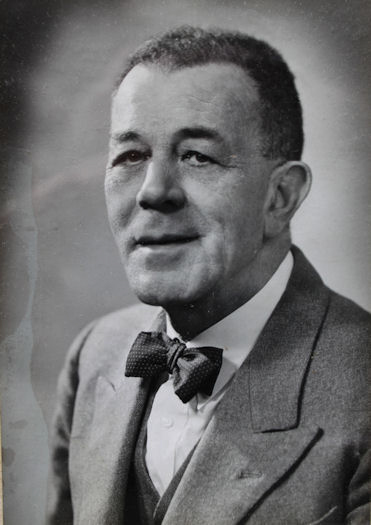
Bernard T. Cadoux

Bernard Campling

Closure notice of M&F London, 1990.

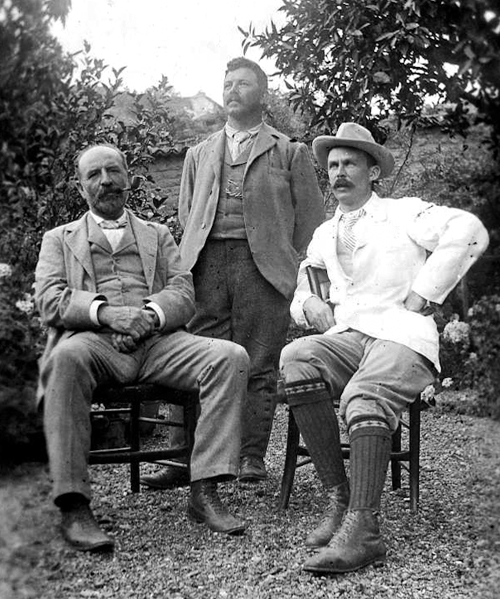
From left: Alexander Geddes, Ben Hodder & Frank McVittie.
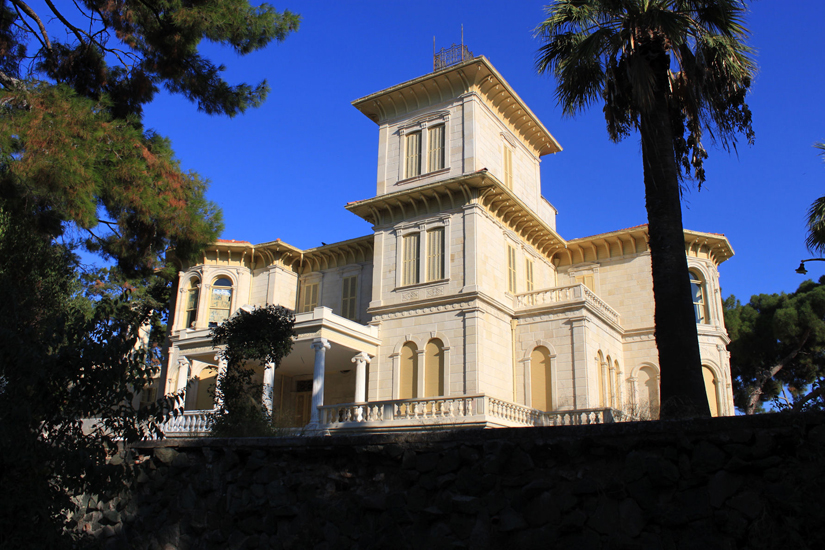
Forbes House of Buca - alternative views.

David Forbes grave, California.

George King Forbes grave in Buca cemetery, Izmir.








Transport of root to Scala Nova [Kuşadası].
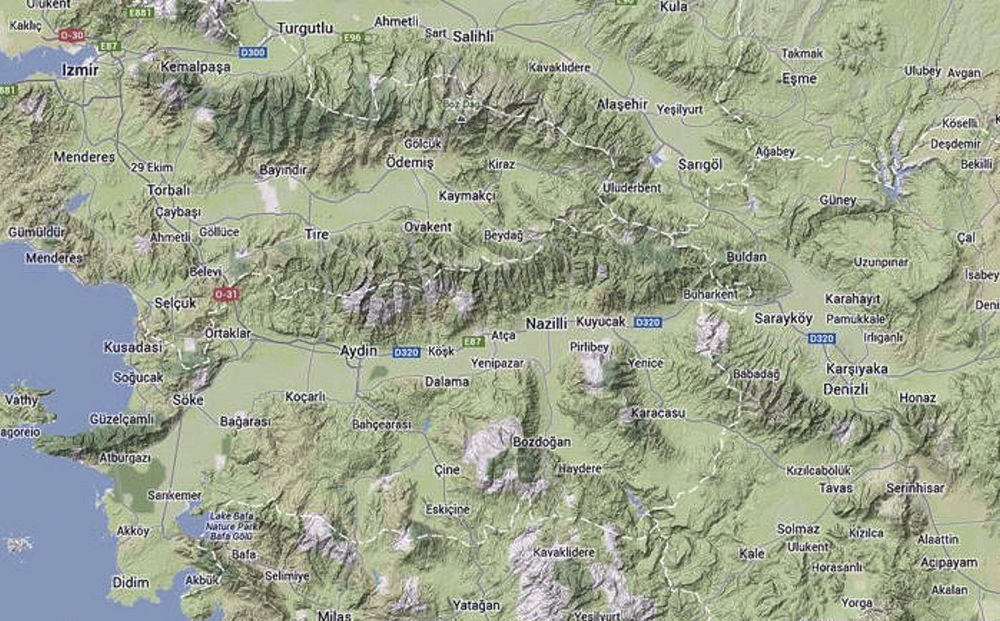

Manager’s house, Söke.


H W Cadoux at Elizavetpol.

Joseph Bliss

Left to right: David Forbes, Herbert Cadoux, possibly T S Catto.

MacAndrew & Forbes offices, Smyrna.

Robert MacAndrew.

Willim H Cadoux.


S Y Calanthe, David Forbes yacht.
Short Bliss family tree.
Short Forbes family tree.
Short MacAndrew family tree.

